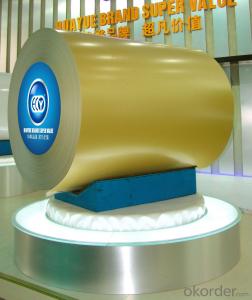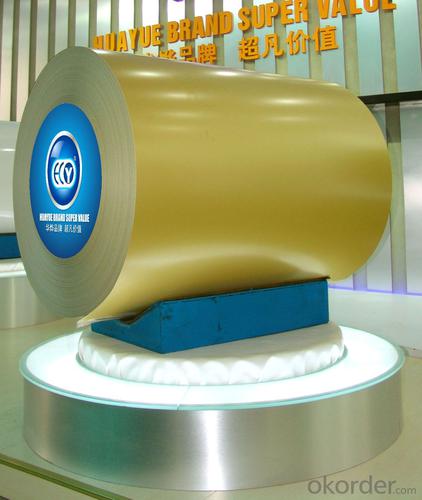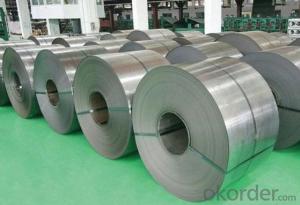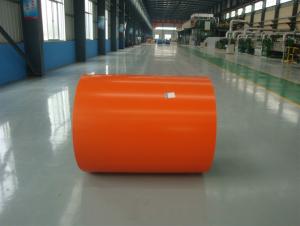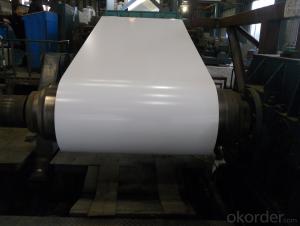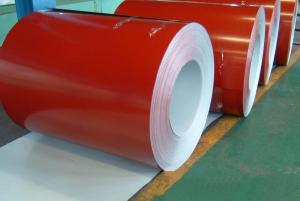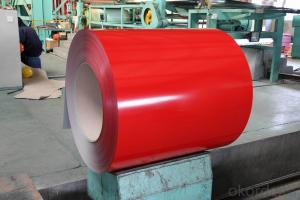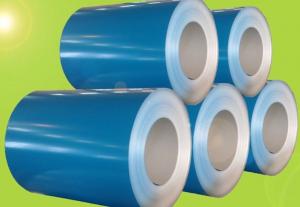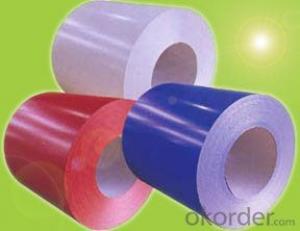Prepainted Aluzinc Steel Coils
- Loading Port:
- China Main Port
- Payment Terms:
- TT OR LC
- Min Order Qty:
- -
- Supply Capability:
- -
OKorder Service Pledge
OKorder Financial Service
You Might Also Like
Product Description:
Prepainted Aluzinc Steel Coil-0.47mm
With GL as base metal, after pretreatment (degrease and chemical treatment) and liquid dope with several layers of color, then after firing and cooling, finally the plate steel is called pre-painted aluzinc steel. Pre-painted Aluzinc steel is good capable of decoration, molding, corrosion resistance. It generally displays superior workability, durability and weather resistance.
General Information Of Prepainted Aluzinc Steel Coil-0.47mm
Thickness | 0.23-1.2mm (BMT) |
Width | 900-1250mm |
Alu-zinc Coating | 50-150g/m2 |
Internal Diameter | 508mm or 610mm |
Color | According to RAL color fan |
Coil Weight | 4-8MT |
Quality | Commercial and structural quality |
Paint | Polyester paint for topside, epoxy for reverse |
Standard | JIS G 3322, ASTM A755M, EN 10169 |
Package | Full wrapped with anti-damped paper inside, iron sheet wrapped outside, and bundled by iron strips |
Base Steel Grade | SGCC, SGCD, DX51D+Z DX52D+Z; S200GD, S220GD, S280GD,S350GD,CS,FS,SS |
Technical Data Of Prepainted Aluzinc Steel Coil-0.47mm
Chemical Composition | C | Si | Mn | P | S |
0.04-0.06% | 0.01-0.03% | 0.18-0.22% | 0.014-0.016% | 0.006%-0.009% |
Technical Data Of Prepainted Aluzinc Steel Coil-0.47mm
Yield Strength | (Mpa) 280-320 |
Tensile Strength | (Mpa) 340-390 |
Elongation | 20%-30% |
Reverse Impact | 9J |
T-bending | ≥2T |
Pencil Hardness | ≥2H |
Duration Of Salt Spray Test | 500 H |
Bending At 180 Degree | No crack, purling and fraction |
Application Of Prepainted Aluzinc Steel Coil-0.47mm
It can be widely used in transportation, light industry, civil usage and farming. It is also the perfect building material in construction for making steel roofing, corrugate sheet, sandwich panel for wall or roofing, facade wall,shutters and home appliance.
Packaging & Delivery Of Prepainted Aluzinc Steel Coil-0.47mm
The packing of coils consists of anti-damp paper, PVC film, hardboard paper, steel box, strapped with steel strips, fitted with locks and edge protectors and guarantees the optimal condition of the delivered goods. Each coil can be additionally fitted with wooden/steel skids(eye to the side) or wooden pallets(eye to the sky).
Delivery Detail: As customer requested
- Q: I work the Copper plating line at a custom plating facility in MI.I like to use jumper cables with the jumper cable clamps to help confirm electric current is getting to my parts that I am plating. The acids in the Acid copper is constantly eating the steel and copper clamps. WIll I get a good enough current through stainless steel clamps? I use stainless steel hooks, but our maintenance man thinks that is one of the reasons why I have prblems with my parts turning out. I still think it has to do with the clamps getting eatin up. My question is Is stainless steel as good or reliable enough to run an electrical current to my parts if I am using stainless steel or is it best to use another method to try and get a better connection.Please state your sources or experience with working with electricity. I need to get honest answers and not this is my opinion. We are talking about my making a living so this is important to me so I can bring food home to my table. Thanks for all the help.
- I can only guess. I can't even tell if you are plating some other metal with copper OR if you are plating copper with some other metal. you state that you use the copper clamps only to confirm the current, but I don't see how that works. I suspect that the plating current actually goes through these clamps, so conductivity is very important. But, the conductivity of SS is about 1/5th that of copper, so that will definitely have an effect, and not a good one. .
- Q: I am making a sword of 1060 carbon steel and would like to know how to heat treat it once it's ready, could anyone help please?
- I've okorder for back and forth communication. I could type up some lengthy post, you'd read it and be like I don't have that piece of gear and all my time is wasted.
- Q: What are the environmental considerations associated with steel coil production?
- The environmental considerations associated with steel coil production include the extraction of raw materials, such as iron ore and coal, which can lead to habitat destruction and air/water pollution. The manufacturing process involves energy-intensive operations and emissions of greenhouse gases, contributing to climate change. Waste generated during production, such as slag and dust, can also have negative impacts on the environment if not properly managed. Additionally, the transportation of steel coils over long distances can result in carbon emissions and increase the overall environmental footprint of the product.
- Q: What are the different methods of oiling steel coils?
- There are several methods of oiling steel coils, including applying oil by roll coating, using a spray system, or immersing the coils in an oil bath.
- Q: how many persent of manganese in all types of carbon steel
- No problem with other answers but there is a high carbon/manganese steel called Hadfields Steel which has been used as armour plate in pilots seats in fighter aircraft in the second world war.This steel contains about 13% manganese and about 1.5 % carbon and is non-magnetic because it retains it's high temperature crystal type(austenite).When it is stuck with a bullet it absorbs the energy of the strike by changing crystal structure to the magnetic form of iron(in this case shock Martensite),I should think that it still has a role in the scoops and picks in earth-moving and farming blades.Well you did ask about all types of carbon steel!
- Q: How are steel coils inspected for width?
- Steel coils are inspected for width using various methods to ensure they meet the required specifications. One common method is to use a caliper gauge, also known as a micrometer, which measures the width of the coil by physically contacting its edges. The operator places the caliper gauge at various points along the width of the coil and records the measurements. This method allows for precise measurements and helps identify any inconsistencies or deviations from the desired width. Another method used for inspecting steel coil width is laser measurement. Laser sensors are positioned on both sides of the coil, and they emit a laser beam that scans across the width of the coil. The sensors detect the distance between the coil's edges and provide accurate width measurements. This non-contact method is highly efficient and can quickly inspect the width of the coil without any physical contact or potential damage. In addition to these methods, some advanced systems use computer vision technology for width inspection. Cameras and image processing software are employed to capture images of the coil's edges. The software analyzes these images and calculates the width based on the detected edges. This method allows for high-speed inspections and can detect any irregularities in the width of the coil. Overall, steel coils are inspected for width using a combination of physical gauges, laser sensors, and computer vision technology. These methods ensure that the coils meet the required width specifications and help maintain quality control in the steel manufacturing process.
- Q: What are common uses for steel coils?
- Steel coils are commonly used in various industries such as automotive, construction, and manufacturing for applications like sheet metal fabrication, structural components, pipes, and electrical appliances.
- Q: How do steel coil manufacturers handle custom orders?
- Steel coil manufacturers handle custom orders by following a systematic process that involves understanding the specific requirements of the customer, designing and producing the custom coils, and ensuring quality control throughout the manufacturing process. Firstly, when receiving a custom order, manufacturers must thoroughly understand the customer's specific needs. This involves detailed communication and collaboration with the customer to gather information about the desired specifications, dimensions, tolerances, and other special requirements. Manufacturers may also provide technical expertise and guidance to the customer to ensure that the custom order can be successfully produced. Once the requirements are clearly defined, manufacturers proceed with designing and engineering the custom steel coils. This involves utilizing advanced software and engineering tools to create detailed designs and specifications that meet the customer's unique needs. Manufacturers may also create prototypes or samples for the customer's approval before proceeding with full-scale production. After the design phase, manufacturers begin the production process. This typically involves sourcing the appropriate raw materials, such as steel coils of the required composition and thickness. The coils are then processed through various manufacturing stages, including cutting, shaping, and forming, to achieve the desired dimensions and shapes. Specialized equipment and machinery are used to ensure precision and accuracy throughout the production process. Quality control is a crucial aspect of handling custom orders. Manufacturers conduct rigorous inspections and testing procedures at various stages of production to ensure that the custom coils meet the customer's specifications and industry standards. This includes checking for dimensional accuracy, surface finish, mechanical properties, and any other specific requirements set by the customer. Manufacturers may also involve third-party inspection agencies or provide customers with test reports and certifications for quality assurance. Finally, once the custom steel coils are manufactured and pass all quality checks, they are carefully packaged and delivered to the customer. Manufacturers ensure proper packaging and shipping methods to prevent any damage during transit and ensure the coils reach the customer in optimal condition. In summary, steel coil manufacturers handle custom orders by closely collaborating with customers, designing and engineering specialized coils, ensuring quality control throughout the production process, and delivering the custom coils to the customer's satisfaction. This systematic approach allows manufacturers to meet the unique requirements of each customer and deliver high-quality custom steel coils.
- Q: Cold rolled steel coil steel, what is the difference?
- Steel rolling process is different from the steel produced naturally different!
- Q: What are the main raw materials used in making steel coils?
- The main raw materials used in making steel coils are iron ore, coal, and limestone.
Send your message to us
Prepainted Aluzinc Steel Coils
- Loading Port:
- China Main Port
- Payment Terms:
- TT OR LC
- Min Order Qty:
- -
- Supply Capability:
- -
OKorder Service Pledge
OKorder Financial Service
Similar products
Hot products
Hot Searches
Related keywords
